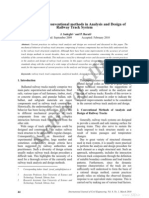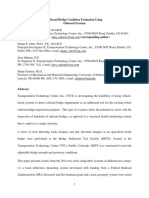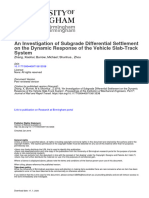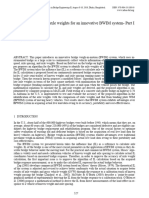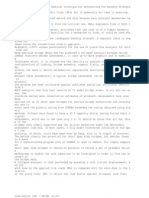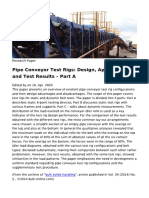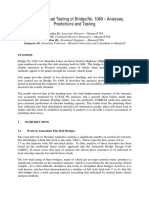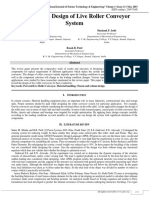Structural Identification of A Cantilevered Truss To Inform Live Load Rating
Structural Identification of A Cantilevered Truss To Inform Live Load Rating
Uploaded by
Lucas HoodCopyright:
Available Formats
Structural Identification of A Cantilevered Truss To Inform Live Load Rating
Structural Identification of A Cantilevered Truss To Inform Live Load Rating
Uploaded by
Lucas HoodOriginal Title
Copyright
Available Formats
Share this document
Did you find this document useful?
Is this content inappropriate?
Copyright:
Available Formats
Structural Identification of A Cantilevered Truss To Inform Live Load Rating
Structural Identification of A Cantilevered Truss To Inform Live Load Rating
Uploaded by
Lucas HoodCopyright:
Available Formats
Structural Identification of a Cantilevered Truss to Inform Live Load Rating
Nathaniel C. Dubbs1
1
Intelligent Infrastructure Systems, Philadelphia, PA, ndubbs@iisengineering.com
ABSTRACT: A steel cantilevered truss was found to have unsatisfactory ratings for critical truss
members, gusset plates and targeted floor system components. A structural identification (St-Id) program
was designed and implemented to compute calibrated load ratings for the critical components via
controlled load testing. The cantilevered truss contained a variety of movement mechanisms, including
internal releases near the pin and hanger details between the anchor and suspended spans. The St-Id
application was used to show that the movement releases performed in a non-linear manner and as a
function of the loading vehicle position. This case study documents the application and lessons learned.
Test Structure and Measured Data
A long span steel cantilevered deck truss was subject to routine permit vehicle crossings. The bridge’s
rating was such that it did not allow the permit vehicles to cross with traffic, rather they required a police
escort to close the bridge resulting in an expense to the owner. Thus, the bridge’s owner was interested in
more accurately establishing the live load rating of the truss to evaluate whether the permit vehicles could
freely cross the bridge mixed with general traffic. A live load testing program was developed to measure
the load distribution of a known load which would then serve as the basis for an FE model calibration
effort.
To better understand the structure, a thorough document review effort was carried out in addition to a site
visit. A main objective of the document review was to identify all pieces of information need to construct
an FE model, such as geometry, cross sections, material properties, boundary conditions, and any changes
in the structure over its life, such as deterioration or retrofits. The bridge was built in the 1950s and
consists of fourteen spans, three of which are short multi-girder approach structures with the remaining
eleven consisting of long deck truss superstructures. The bridge was designed in a cantilever fashion, with
a general assembly of spans as shown below in Figure 1.
Figure 1: Schematic of Typical Cantilevered Deck Truss Assembly
Each suspended span is simply supported by pin-connected hangers to the adjacent cantilever spans. The
designers achieved this while maintaining the continuity of the truss lines by incorporating a series of
slotted dummy members which allowed for the free expansion and contraction of the suspended span. As
seen in Figure 1 above, the dummy members are highlighted in green with the pin and hanger members
highlighted in red. The dummy members were either pinned or slotted depending on the location to allow
the suspended span to be simply supported.
Collection of SHM Case Studies by ASCE SEI Methods of Monitoring Committee
An FE model was developed to support the design of an
instrumentation plan as well as to eventually compute
live load demands to support the calibrated load rating
objective. The FE model was developed in Strand7
where truss members and floor system components were
represented by beam elements and the deck was
represented by shell elements (Figure 3).
The model was evaluated for uncertain components,
namely places where the engineer had to make
assumptions as to the bridge’s actual behavior. An
example of an uncertain model component would be the Figure 2: View of Dummy Member at Suspended
expansion bearings stiffness at the piers. A thorough Span Hanger Detail
sensitivity study was then carried out to identify the
locations in a typical structural unit which were the most
sensitive to not only applied load but also to the
uncertain components of the FE model. The interested
reader can find more details regarding the uncertain
model components and sensitivity study process in
Dubbs & Yarnold [1].
Figure 3: Extruded View of 3D FE Model
The truss instrumentation plan utilized a total of thirty-
six vibrating wire strain gages to measure
the axial forces in three sections of the
truss, eighteen truss members in total. Two
sensors were located on opposing sides of
the welded box sections at the vertical
neutral axis. This sensor configuration
allowed for the measurement of only axial
strains. The three sections of the truss
instrumented are shown in red in Figure 4.
A live load test of one typical structural
unit was carried out during a planned overnight Figure 4: Instrumented Sections of the Truss
bridge closure. The bridge was loaded up to
480,000lbs in a variety of configurations and total weights. The live load testing utilized both crawl speed
(5mph) and static positioning of the trucks. The strain gages were sampled at a rate of 20Hz with a
Campbell Scientific CDM-VW305 peripheral and a CR3000 datalogger. Due to the interaction of the
spans through the dummy members, the crawl speed and static positioning of the trucks was implemented
over three adjacent spans to characterize the transfer of loads from the suspended span to the anchor span
and what role the dummy members played, if any.
The measured strains were first reviewed for quality control purposes by visually inspecting for obvious
spikes or errors. The data was then reduced from its raw time history format ( Figure 5) into a table of
average strain response while a vehicle was at one location. Vehicle locations were documented by
toggling a Boolean variable in the data acquisition program, indicated in the figure by the dashed lines.
Collection of SHM Case Studies by ASCE SEI Methods of Monitoring Committee
Figure 5: Strain Response in the Truss Members due to a Crawl Speed Load Event
SHM Methodology and Results
The FE model was calibrated by minimizing the difference between the observed strain response per
truck location and the FE model prediction of the same loading configuration. The minimization process
was carried out in an automated fashion using the computational software MATLAB and built-in
optimization functions. The model uncertainties identified earlier in the project were varied between
feasible bounds until a globally minimum solution was achieved. The challenge for this bridge was that
there was no single global optimum solution; rather there were two. It was found that the dummy
members were actually participating in the global load distribution of the structure, but only when the
vehicles were in specific positions along the roadway. The interested reader is encouraged to read Dubbs
[2] for more details on this optimization challenge.
The two calibrated FE models, representing the active or passive roles the dummy members played in the
global load distribution were utilized to compute the live load demands for legal rating vehicles. As a
result of this project, it was found that permit vehicles of specific configurations were not required to have
police escorts and could travel freely with routine traffic, resulting in a net savings for the bridge owner.
Lessons Learned
The case study presented herein served valuable lessons learned for the author. First and foremost, it is
very important to not only consider performance of primary load carrying elements during a load test, but
to also consider how the movement mechanisms, if present, will impact the participation of those
members over time. For this project, an initial attempt at model calibration utilized strain response from
all positions of the truck in the same error function, with very poor results. It was not until the error
function was modified to allow for two unique solutions as a function of varying truck positions that it
was realized that the dummy member participation was non-linear with respect to vehicle position. It is
important to consider this in similar applications.
References
[1] Dubbs, N. C., & Yarnold, M. (2014, August). Optimal Sensor Placement for Condition Assessment of
a Cantilever Truss Bridge. In NDE/NDT for Structural Materials Technology for Highway & Bridges (pp.
106-113).
[2] Dubbs, N. C. (2015, April). Interpretation and Reporting of Load Test Results from a Cantilever-Truss
Bridge with Internal Movement Mechanisms. In Structures Congress 2015 (pp. 332-344).
Collection of SHM Case Studies by ASCE SEI Methods of Monitoring Committee
You might also like
- SeaBat T-Series Rackmount - OpMan - 2Document184 pagesSeaBat T-Series Rackmount - OpMan - 2Stoyan GeorgievNo ratings yet
- Platinum Palladium PhotographsDocument2 pagesPlatinum Palladium PhotographsAntonio Jorge Valerio0% (1)
- Wheel Load Contact AreaDocument13 pagesWheel Load Contact AreaGnabBang100% (1)
- 2014 Jacquard tc207 Foundations by Prestressing Anchors of The "Villa Mediterranee enDocument5 pages2014 Jacquard tc207 Foundations by Prestressing Anchors of The "Villa Mediterranee enLucas HoodNo ratings yet
- Vehicle-Based Detection of Changes in Bridge ConditionDocument18 pagesVehicle-Based Detection of Changes in Bridge ConditionAnna RakoczyNo ratings yet
- Finite Element Model Updating of A Suspension Bridge Using Ansys SoftwareDocument8 pagesFinite Element Model Updating of A Suspension Bridge Using Ansys SoftwareQwaAlmanlawiNo ratings yet
- Railroad Bridge Condition Evaluation Using Onboard SystemDocument26 pagesRailroad Bridge Condition Evaluation Using Onboard SystemAnna RakoczyNo ratings yet
- Evaluation of Safety and Operational Efficiency Using Structural Health Monitoring EnhancementDocument7 pagesEvaluation of Safety and Operational Efficiency Using Structural Health Monitoring EnhancementHamada Shoukry MohammedNo ratings yet
- Unit Conversion TableDocument217 pagesUnit Conversion TableNull NullNo ratings yet
- Experimental Evaluation of The Static and Dynamic Characteristics of An Offshore Crane ModelDocument8 pagesExperimental Evaluation of The Static and Dynamic Characteristics of An Offshore Crane ModelUmanath R PoojaryNo ratings yet
- VanDyk Et Al 2016 JRRT Methods For Quantifying Rail Seat LoadsDocument11 pagesVanDyk Et Al 2016 JRRT Methods For Quantifying Rail Seat LoadsSajid IqbalNo ratings yet
- 1 Ijssd Submission Revised 15-10-2020Document23 pages1 Ijssd Submission Revised 15-10-2020n.mordaNo ratings yet
- Monitoring Bridge Dynamic Behaviour Using An Instrumented Two Axle Vehicle P.J. Mcgetrick, A. González & E.J.ObrienDocument8 pagesMonitoring Bridge Dynamic Behaviour Using An Instrumented Two Axle Vehicle P.J. Mcgetrick, A. González & E.J.ObrienArturo GonzalezNo ratings yet
- Parameter Identification of Vehicles Movingon Continuous BridgesDocument21 pagesParameter Identification of Vehicles Movingon Continuous BridgesAugusto César Santos PeixotoNo ratings yet
- Dynamic Load Allowance For Reinforced Concrete Bridges: Jerry W. Wekezer, Eduardo E. TaftDocument13 pagesDynamic Load Allowance For Reinforced Concrete Bridges: Jerry W. Wekezer, Eduardo E. Taftpu3bsdNo ratings yet
- Noncontact Operational Modal Analysis of Light Poles by Vision-Based Motion-Magnification MethodDocument12 pagesNoncontact Operational Modal Analysis of Light Poles by Vision-Based Motion-Magnification MethodBridge&StructureNo ratings yet
- 5wacmge ArtigoDocument14 pages5wacmge ArtigoRajshri sumanNo ratings yet
- LiteratureDocument22 pagesLiteratureSHRADDHA KADAMNo ratings yet
- Nonlinear Finite Element Analysis of Latticed Transmission Towers 1993Document11 pagesNonlinear Finite Element Analysis of Latticed Transmission Towers 1993ciscoNo ratings yet
- An Investigation of Subgrade Differential Settlement On The Dynamic Response of The Vehicle Slab Track SystemDocument26 pagesAn Investigation of Subgrade Differential Settlement On The Dynamic Response of The Vehicle Slab Track SystemAndrew OwenNo ratings yet
- Biondi Et Al 2005Document11 pagesBiondi Et Al 2005Saymo Wendel de Jesus Peixoto VianaNo ratings yet
- Bus Body PDFDocument5 pagesBus Body PDFjohnsonNo ratings yet
- Predicted and Measured Performance of PRDocument10 pagesPredicted and Measured Performance of PRrd303reNo ratings yet
- A Simplified Load Rating Method For Masonry and Reinforced Concrete Arch BridgesDocument37 pagesA Simplified Load Rating Method For Masonry and Reinforced Concrete Arch BridgesrcidgpoNo ratings yet
- Tower Analysis - More Then A Truss PDFDocument12 pagesTower Analysis - More Then A Truss PDFrichificNo ratings yet
- A Parametric Study of Traffic Load Effects in Medium Span BridgesDocument13 pagesA Parametric Study of Traffic Load Effects in Medium Span BridgesKhalilNo ratings yet
- Vehicle-Bridge Interactive Analyses On The Lagoscuro ViaductDocument14 pagesVehicle-Bridge Interactive Analyses On The Lagoscuro ViaductNavid SalamiPargooNo ratings yet
- Bridge Load Distribution PDFDocument9 pagesBridge Load Distribution PDFRakesh KalitaNo ratings yet
- Setting Up A Real-Time Train Load Monitoring System in The UK Using Bridge Weigh-In Motion Technology - A Case StudyDocument4 pagesSetting Up A Real-Time Train Load Monitoring System in The UK Using Bridge Weigh-In Motion Technology - A Case StudyFarhad HuseynovNo ratings yet
- Dynamic Test-Jibanananda SetuDocument14 pagesDynamic Test-Jibanananda Setu123epcNo ratings yet
- Numerical Simulation of Structural Behaviour of Transmission TowersDocument16 pagesNumerical Simulation of Structural Behaviour of Transmission TowersKrisnandha RahardianNo ratings yet
- Solid Modeling and Finite Element Analysis of An Overhead Crane BridgeDocument7 pagesSolid Modeling and Finite Element Analysis of An Overhead Crane Bridgepjustino1970No ratings yet
- Rating and Upgrading of Steel Bridges Using Finite Element ModelingDocument11 pagesRating and Upgrading of Steel Bridges Using Finite Element ModelingEuNo ratings yet
- RNL-A-07 Rollover Analysis of Bus Body Structure VolvoDocument7 pagesRNL-A-07 Rollover Analysis of Bus Body Structure VolvoAlejandro ZamoraNo ratings yet
- The Role of Track Stiffness and Its Spatial Variability On Long-Term Track Quality DeteriorationDocument17 pagesThe Role of Track Stiffness and Its Spatial Variability On Long-Term Track Quality DeteriorationMarina GamaNo ratings yet
- Vehiclestructure Dynamic Part1Document3 pagesVehiclestructure Dynamic Part1dbhawal6388No ratings yet
- Ultimate Strength Ship Transverse FrameDocument27 pagesUltimate Strength Ship Transverse FrameClaudio RuggieriNo ratings yet
- Advances in Design Theories of High-Speed Railway Ballastless TracksDocument9 pagesAdvances in Design Theories of High-Speed Railway Ballastless TracksKlarc CamachoNo ratings yet
- Bwim MatlabDocument10 pagesBwim MatlabAnh Đức Trần LêNo ratings yet
- Computers and Structures: Nan Zhang, He XiaDocument9 pagesComputers and Structures: Nan Zhang, He Xialeo2902No ratings yet
- Yield Line AnalysisDocument2 pagesYield Line AnalysisGie SiegeNo ratings yet
- Considerations On Longitudinal Dynamic Effects ofDocument17 pagesConsiderations On Longitudinal Dynamic Effects ofAdrian StroeNo ratings yet
- Impact Factors On Short Span Bridges Due To Multiple Vehicle Presence - BradyDocument10 pagesImpact Factors On Short Span Bridges Due To Multiple Vehicle Presence - BradyaapennsylvaniaNo ratings yet
- Live Load Effects in Hammer-Head Piers of Continuous HighwayDocument16 pagesLive Load Effects in Hammer-Head Piers of Continuous HighwaylucasssbotelhoNo ratings yet
- Pipe Conveyor Test Rigs Design Application and Test Results Part ADocument19 pagesPipe Conveyor Test Rigs Design Application and Test Results Part AFenglin YAONo ratings yet
- 028 - Pressley Destructive Testing 1049Document12 pages028 - Pressley Destructive Testing 1049tomNo ratings yet
- CD Paper Pag 227Document10 pagesCD Paper Pag 227Anonymous lEBdswQXmxNo ratings yet
- Study of Total StationDocument8 pagesStudy of Total StationGopal Krishnan100% (2)
- Considerations For Mechanistic Design of Concrete Sleepers and Elastic Fastening Systems in North AmericaDocument8 pagesConsiderations For Mechanistic Design of Concrete Sleepers and Elastic Fastening Systems in North AmericaMin Chan MoonNo ratings yet
- TRB 2011 Paper FinalDocument15 pagesTRB 2011 Paper FinalTimtheausNo ratings yet
- Finite Element Analysis of An Overhead Crane BridgeDocument6 pagesFinite Element Analysis of An Overhead Crane BridgeSebastian PopNo ratings yet
- A Review On Design of Live Roller Convey PDFDocument3 pagesA Review On Design of Live Roller Convey PDFGaneshNo ratings yet
- Vehicle/bridge Interaction Modeling and Validation For 1 Short Span Railway Bridges.Document15 pagesVehicle/bridge Interaction Modeling and Validation For 1 Short Span Railway Bridges.Anna RakoczyNo ratings yet
- SHM of Bridges Using WIMDocument10 pagesSHM of Bridges Using WIMsachinoakNo ratings yet
- Simulation of Vertical Dynamic Vehicle-Track InterDocument26 pagesSimulation of Vertical Dynamic Vehicle-Track InterBARIŞ KalyonNo ratings yet
- 1 s2.0 S0143974X05001045 MainDocument13 pages1 s2.0 S0143974X05001045 Mainburaksait.yildirimNo ratings yet
- Track Structure Interaction Analysis Using FE Techniques Lusas ArchiveDocument8 pagesTrack Structure Interaction Analysis Using FE Techniques Lusas ArchiveMURTHYNo ratings yet
- Research Article: A Data-Driven Approach For Bridge Weigh-in-Motion From Impact Acceleration Responses at Bridge JointsDocument14 pagesResearch Article: A Data-Driven Approach For Bridge Weigh-in-Motion From Impact Acceleration Responses at Bridge JointshromanvaNo ratings yet
- Mathematical Traffic Load Modelling andDocument38 pagesMathematical Traffic Load Modelling andKhalilNo ratings yet
- Kim 2005Document19 pagesKim 2005Giulio PalamàNo ratings yet
- Neues verkehrswissenschaftliches Journal - Ausgabe 16: Capacity Research in Urban Rail-Bound Transportation with Special Consideration of Mixed TrafficFrom EverandNeues verkehrswissenschaftliches Journal - Ausgabe 16: Capacity Research in Urban Rail-Bound Transportation with Special Consideration of Mixed TrafficNo ratings yet
- Handbook of Optimization in the Railway IndustryFrom EverandHandbook of Optimization in the Railway IndustryRalf BorndörferNo ratings yet
- High Speed Off-Road Vehicles: Suspensions, Tracks, Wheels and DynamicsFrom EverandHigh Speed Off-Road Vehicles: Suspensions, Tracks, Wheels and DynamicsNo ratings yet
- Improving Seismic Performance of FramedDocument13 pagesImproving Seismic Performance of FramedLucas HoodNo ratings yet
- Human Comfort Study of Medium Rise Reinforced Concrete Buildings Under Wind ExcitationsDocument11 pagesHuman Comfort Study of Medium Rise Reinforced Concrete Buildings Under Wind ExcitationsLucas HoodNo ratings yet
- Composite Column-Importance and Design Methodology As Per Indian CodeDocument5 pagesComposite Column-Importance and Design Methodology As Per Indian CodeLucas HoodNo ratings yet
- Battle Bikes 2.4 PDFDocument56 pagesBattle Bikes 2.4 PDFfranzyland100% (1)
- Course Caterpillar c6 6 Engines Acert Technology BenefitsDocument34 pagesCourse Caterpillar c6 6 Engines Acert Technology BenefitsGanapati Hegde100% (10)
- Marketing and Management Models A Guide To Understanding and Using Business Models First Edition Yvonne Helen Strong Download PDFDocument53 pagesMarketing and Management Models A Guide To Understanding and Using Business Models First Edition Yvonne Helen Strong Download PDFniffashoraj100% (2)
- Firetec Bs 7846 LPCB Basec Approved Power CableDocument5 pagesFiretec Bs 7846 LPCB Basec Approved Power CableSanjay MNo ratings yet
- The HyperbolaDocument13 pagesThe HyperbolaJorge VargasNo ratings yet
- WT198CDocument2 pagesWT198CaaquilNo ratings yet
- BPP Q3 Module 2Document16 pagesBPP Q3 Module 2Laine Acire100% (2)
- DLP SCIENCE YEAR 3 - ANIMALS CHARACTERISTICS - Print - QuizizzDocument9 pagesDLP SCIENCE YEAR 3 - ANIMALS CHARACTERISTICS - Print - QuizizzpiriyachandranNo ratings yet
- Nexus 9500 Series Switches Data SheetDocument14 pagesNexus 9500 Series Switches Data SheetHoang HanNo ratings yet
- Intro Calapan City Pet HavenDocument14 pagesIntro Calapan City Pet HavenMark Brillo TorregozaNo ratings yet
- Products 1 2 1 480Document8 pagesProducts 1 2 1 480Михаил ЛазаревичNo ratings yet
- Amity Institute of Environmental Sciences: B. Tech. Semester I Environmental StudiesDocument22 pagesAmity Institute of Environmental Sciences: B. Tech. Semester I Environmental StudiesefjwfdfefefefffefNo ratings yet
- Paddle Wheel and PropellerDocument8 pagesPaddle Wheel and PropellerMark Angelo NioscoNo ratings yet
- Ghari Detergent - WikipediaDocument5 pagesGhari Detergent - WikipediaAkshayNo ratings yet
- Introducing Uca Fukui SoftwareDocument13 pagesIntroducing Uca Fukui SoftwareKevin Anthony Oré MaldonadoNo ratings yet
- World Class ManufacturingDocument9 pagesWorld Class ManufacturinganupraipurNo ratings yet
- X10 Motion Detector PowerHouse Model PR511Document5 pagesX10 Motion Detector PowerHouse Model PR511AngeloNo ratings yet
- CE CGR: This Datasheet Has Been Downloaded From at ThisDocument7 pagesCE CGR: This Datasheet Has Been Downloaded From at ThisFarooq AhmedNo ratings yet
- Quit Smoking or Quit Breathing: Advocacy Campaign 2019-2020Document5 pagesQuit Smoking or Quit Breathing: Advocacy Campaign 2019-2020John Gilbert B. PaltaoNo ratings yet
- Cept Erc Rec 70-03 PDFDocument7 pagesCept Erc Rec 70-03 PDFDragan StanicNo ratings yet
- Top 30 MCQ Revolution of IndiaDocument4 pagesTop 30 MCQ Revolution of IndiaEthan HuntNo ratings yet
- ATA-100 - TABLA ATA-SUB ATA Rev.2 PDFDocument1 pageATA-100 - TABLA ATA-SUB ATA Rev.2 PDFTincho Cuevas100% (1)
- Gaming Gear TechzonesDocument7 pagesGaming Gear TechzonesNguyễn Tuấn PhátNo ratings yet
- USCAT19 - 85 51 - Hose Clamp Pliers For Click ClampsDocument1 pageUSCAT19 - 85 51 - Hose Clamp Pliers For Click ClampsthailanNo ratings yet
- Project CHEMISTRYDocument9 pagesProject CHEMISTRYNishant NischayaNo ratings yet
- 3U Diversity of Living Things Unit PlanDocument38 pages3U Diversity of Living Things Unit PlanRaquel Nader0% (1)
- LS86 Snoopy 1Document3 pagesLS86 Snoopy 1Daiza LimaNo ratings yet
- DNA Extraction Lab SheetDocument1 pageDNA Extraction Lab SheetStrawberry RoNo ratings yet


